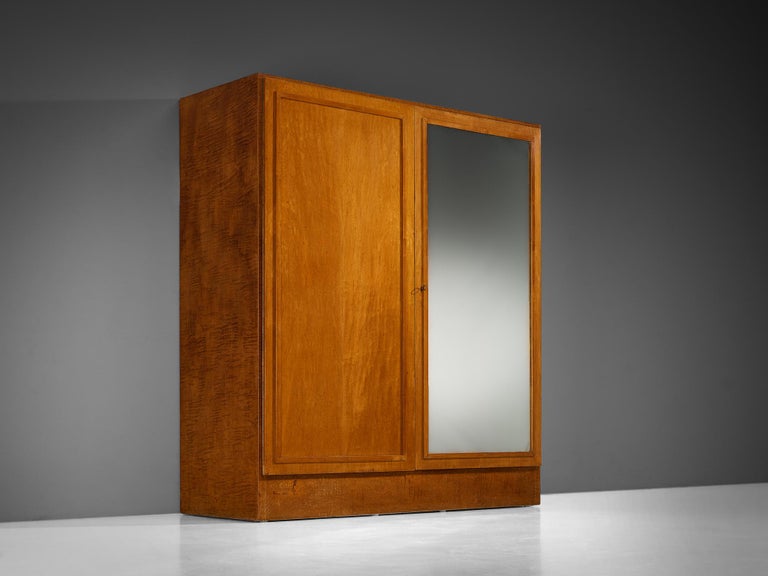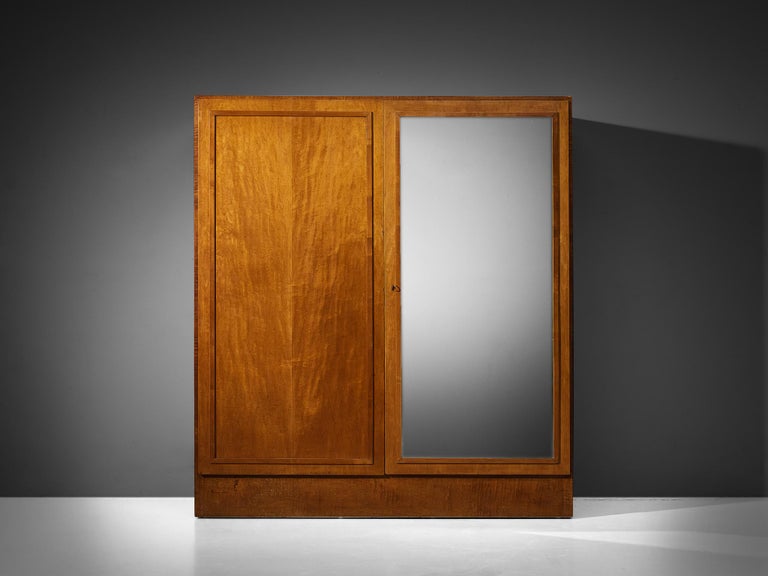









Rare Studio B.B.P.R. Wardrobe in Maple and Mirrored Glass ca. 1933
Studio B.B.P.R. (Gianluigi Banfi, Enrico Peressutti, and Ernesto Nathan Rogers) for Piazza & Mann, wardrobe, maple, mirrored glass, chrome-plated metal, aluminum, Italy, circa 1933
This exceptional armoire, created by Studio B.B.P.R., exemplifies the group's architectural sensibility and refined taste for elegant proportions and simplicity in structure. The piece is exceptionally rare and has remained relatively unknown to the public eye, with limited variations made. However, similar-designed wardrobes gained significant recognition during that period and were prominently featured in Domus magazine issue number 76, in April 1934. The publication dedicated a commentary on several apartments designed by the studio, under the title "Expression of some modern furnishings". The author notes that Studio B.B.P.R. represents a fresh, youthful energy. Their work reflects new ideas and evolving tastes, which they consider important for shaping modern living environments. The furniture by these architects is described as simple, but this simplicity isn't due to cutting out or reducing elements (which is common in minimalism). Instead, it is a result of careful thought and design, ensuring the pieces are functional and in harmony with life. The furniture featured in the depicted residencies encompasses several characteristics, such as clarity, balance, and a sense of peace. These features suggest that the designs are not just visually appealing but also practical and comfortable to live with. The author values the combination of rational material use and an instinctive sense of proportion, highlighting how well the volumes (spaces and forms) are balanced.
This bespoke sideboard exemplifies several of the design principles mentioned, like simplicity achieved through thoughtful composition. A well-considered design with a very minimalist, clean look. The right door features a large mirror, while the left side showcases the natural wood, highlighting its subtle grain and warm tones. The wardrobe uses maplewood in a way that feels natural and harmonious. The wood’s texture is preserved, showing the architects' respect for the materials and their rational use without unnecessary adornment. When opened, the inside reveals a well-organized, functional storage facility. The left side contains a series of drawers and small compartments, while the right side is a spacious hanging area. The central section is adorned with circular niches accented by chromium bars, providing structural decoration without sacrificing functionality. A beautiful piece by Studio B.B.P.R., where every detail - from the calculated proportions to the rational use of materials - is carefully evaluated, imbued with a sense of warmth and liveliness.
Studio B.B.P.R. was an Italian architectural partnership founded in Milan in 1932 by Gianluigi Banfi (1910-1945), Lodovico Barbiano di Belgiojoso (1909-2004), Enrico Peressutti (1908-1976) and Ernesto Nathan Rogers (1909-1969) who had studied at the Politecnico di Milano. B.B.P.R. was thus an acronym formed from the first letters of their family names. The architects found each other in their opposition to fascism in Italy in the 1930s and 1940s during Mussolini's autocratic regime. The architects therefore believed in developing a style that would have no references to contemporary politics. During the Second World War, they all joined the resistance. However, Rogers, a Jew, fled to Switzerland and both Belgiojoso and Banfi were deported to the Mauthausen concentration camp in Austria, where Banfi died in 1945. Despite the immense loss of Banfi, their architectural practice continued in the same name as before the war. Especially during the 1950s, they created many of their great projects. With their designs, they strongly reacted against the International Style with its rectilinear forms and taut plane surfaces that have been completely stripped of applied ornamentation. Instead, the group enriched their buildings with medieval references. For B.B.P.R., their philosophy on art and architecture is somewhat between tradition and modernism; their use of post-beam structures and modular elements parallels with the constructive thinking of modern architects. However, as modernism rejects the existence of historical forms, B.B.P.R. reinterprets history's heritage and continues with respect for the work of their predecessors. Ernesto Nathan Rogers referred to it as “preesistenze ambientali” (the pre-existing environment) and adopt a “caso per caso” (case by case) interpretation to work with, instead of against, the surroundings. One of their well-known designs is the creation of the Torre Velasca in Milan, with strong references to medieval architecture. The architects were also frequently employed to create interior spaces altogether with furniture designs.
Kindly note that the piece is in good, used condition with signs of age and use, including some scratches and dents. For further details, we encourage you to reach out to our team of design specialists.
VAT within the EU: When buying or delivering an item within the EU, VAT usually applies and will be added.
Choose options










Product Details